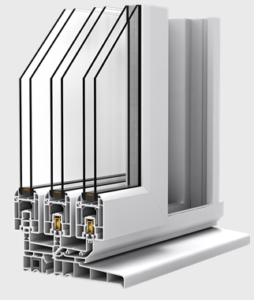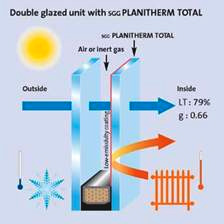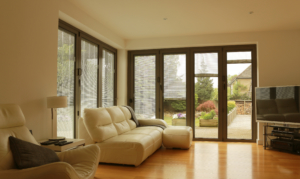Types of Window Glazing: Double, Triple and Low-E Glass
Understanding the different types of window glazing can help you make the most cost-effective and environmentally sustainable choice for your property. For homes and business premises, the right type of glazing can make a big difference to your energy bills. Windows are among the most common sites of heat escape from any building, but proper insulation and glazing can help retain heat. This is achievable with triple-glazed windows, Low-E glazing windows or a combination.

Different Types of Window Glazing
At Longton Glass, we provide a comprehensive range of options, including cutting-edge glass coatings to change how solar heat passes through.
Double Glazing: Pros and Cons
Today, double-glazed windows are standard in new-build properties and have been installed in most older homes.
How Double Glazing Works
The problem with single-glazed windows is that they act as a ‘cold bridge’, an easy pathway for heat to dissipate from inside to outside. The cold air on one side cools the whole pane of glass, which then absorbs heat from the warm air on the other side, cooling the room.
Double glazing works by breaking up this cold bridge, using two layers of glass to trap a sealed pocket of air. This slows heat transfer from inside to outside. The edges of the panes are held by a rubber gasket, which both creates a seal against moisture and warm air and insulates against heat transfer through the frame. The structure of double glazing breaks up the pathway for heat energy to escape from within the building. It also works both ways: on a hot or humid day, double glazing keeps interiors cool.
Pros:
- Reduced energy bills as interior heats more efficiently
- Noise reduction as noise travels similarly to heat
- Reduced condensation as the inner pane is closer to the interior temperature
- Increased property value vs single glazing
Cons:
- More expensive to repair than single-glazing
- Less efficient than triple-glazing
- Solar heat gain can lead to a greenhouse effect in the summer, but shading can mitigate this.
- For some properties, matching double glazing to the style of the building involves an additional cost, but it is not impossible.
Triple Glazed Windows Pros And Cons
You might guess this: triple glazing works the same way as double glazing, but the effect is doubled.
How Triple Glazing Works:
Three layers of glass provide two separate air pockets. The more breaks in the ‘cold bridge’ that draws heat from inside to outside, the slower the heat will transfer. In winter, the outer pane is cooled, the inner pane is warmed, and the middle pane keeps the air pockets separate.
Pros:
- Increased insulation and lower energy bills than double glazing
- Reduced drafts, even if one seal breaks
- Reduced condensation
- Increased strength and security as they are harder to break
Cons:
- Increased weight, which may affect seals
- Higher up-front cost for specialist product
Low-E Glass
Low-E or Low-Emissivity Glass is a coated glass that reduces heat transfer even further. SGG Planitherm Glass adds efficiency to double and triple-glazed windows, lowering the amount of fuel required for heating and thereby emissions.
How Low-E Glazing Works
One side of the glass is coated with a transparent metallic substance, often aluminium. This Low-E coating reflects long-wave thermal radiation back into a room, rather than allowing the glass to absorb it. Low-E double-glazed windows can be designed to maximise solar heat gain and natural light transmission for a more energy-efficient window.
Planitherm’s Low-E coating has a one-way action, so while it keeps heat inside, it does not block the free heat and light from the sun, allowing your home to warm efficiently on a given day.

There are two types of Low-E coating: hard and soft. Hard coats are more durable and best for cooler climates. Soft coats are more effective at reducing solar heat gain so should be used in warmer environments.
Usually, Low-E coatings are not exposed, and are used on the interior side of double glazing, so there is no need to clean the coated side. In hotter climates, the Low E coating is likely to be on the exterior of the glass, and will require gentle cleaning with no metal implements.
Pros:
- Low-E Glazing reduces heat transfer, saving fuel and money on heating
- Reduces glare
- No tint as with other coatings
- Durable and hard-wearing, great for harsh environments
Cons:
- Higher initial cost
At Longton Glass, we supply low-E glazing windows that are coated on the inside of double and triple-glazed units.

Comparison: Double vs Triple Glazing vs Low-E
While Low-E Glass can be used with double or triple glazing, this table highlights where the benefits lie.
| Glazing Type | Double Glazing | Triple Glazing | Low-E Glazing |
|---|---|---|---|
| Cost | Medium | High | Mid-High |
| Energy Efficiency | C-A Rating | B-A+ Rating | B-A++ Rating |
| Durability | High | High | High |
| Security | Med-High | High | No Change by applying Low-E |
Beat Rising Energy Prices with Efficient Window Glazing
Combining Low-E Coating with Double or Triple-Glazed Windows can dramatically improve the energy efficiency of any property. Balance the up-front costs against the money saved on heating and the increase in property value these windows will bring. These glazing options are available with UPVC windows or aluminium windows, making it easy to customise windows and match the character of your building.


